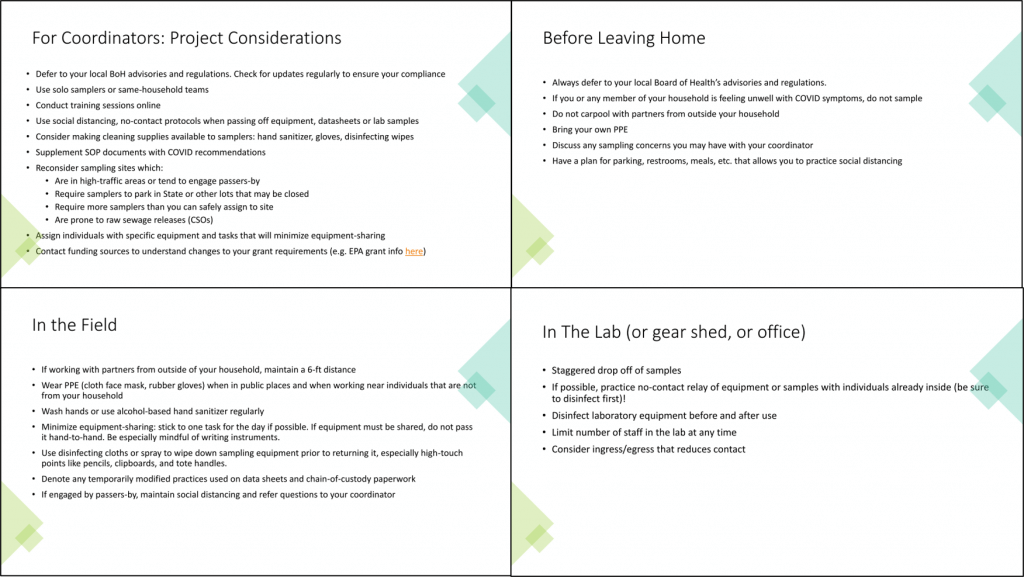Citizen-Based Water Quality Monitoring and COVID-19: Best Practices and Resources
This post originally appeared on the Urban Waters Learning Network blog.
We at the Urban Waters Learning Network (UWLN) and River Network know that many of our members who do water quality monitoring have questions about how to proceed with that work under the stay-at-home orders and social distancing measures that are in place during our current COVID-19 pandemic. We recently reached through the UWLN to see what different members are doing.
Some locations, like New York City and San Diego, have suspended all water quality monitoring until further notice due to city and/or state mandates. These locations are still waiting for guidance on when and how to re-open volunteer-led sampling programs. Meanwhile, other locations are maintaining their sampling sites using proper social distancing methods and other safe protocols. While each state or municipality may have different guidelines, organizations from across the United States are connecting and putting together ideas on best practices for volunteer-based water quality sampling programs.
Spearheading this coordinated effort, the USA Volunteer Water Monitoring Network is developing a list of “best practice” recommendations for citizen-based field sampling in the time of COVID. Kris Stepenuck (University of Vermont and co-coordinator of the water monitoring network) and Jill Carr (Massachusetts Bays National Estuary Program and a water monitoring network member) hosted a virtual meeting on Tuesday, April 21 to discuss existing guidelines from several locations as well as to give others a platform to share information pertaining to this topic.
In the webinar—Citizen-based Aquatic Field Sampling in the Time of COVID-19—the hosts organized some best practices for program coordinators, field crews and lab or classroom personnel to consider, organized into lists for “before leaving home,” “in the field,” and “in the lab.”

From the webinar—Citizen-based Aquatic Field Sampling in the Time of COVID-19—the diagram above depicts the authors’ summarized best practices for different parts of the water quality monitoring process.
A recording of the webinar, webinar slides, a summary of best practices, a summary of the webinar discussion, and a crowdsourced Google spreadsheet with guidelines and resources can all be found on their COVID 19 resources page. All this information is accessible to water quality monitoring teams to use and implement as they see fit and in cooperation with their local or state mandates. The google spreadsheet is a living document that is open for anyone to share information and resources.
Where water quality events have been cancelled or postponed, organizations are developing actions that members of their communities can do from home. For example, instead of their annual event of Snapshot Day—the largest single day water quality sampling event in the state of California—The Coastal Watershed Council has offered home-based water quality and watershed science activities.
Because their volunteer training programs cannot be conducted in person, some organizations are providing online courses for volunteers. The New York State Department of Environmental Conservation is offering online training for their Water Assessments by Volunteer Evaluators (WAVE) citizen-based water quality assessment program. Similarly, The Environmental Quality Institute in Asheville, NC has online refresher courses on macroinvertebrate sampling.
There are other important questions about water quality and COVID-19 in which our networks are interested in learning more, like:
Can sewage pollution be another vector for transmitting the virus that causes COVID-19? What steps should water quality monitoring teams take to limit their exposure?
While there is still more to learn before answering these questions definitively, the Centers for Disease Control and Prevention offer some information about Water and COVID-19:
“Recently, the virus that causes COVID-19 has been found in untreated wastewater. While data are limited, there is no information to date that anyone has become sick with COVID-19 because of exposure to wastewater. Standard practices associated with wastewater treatment plant operations should be sufficient to protect wastewater workers from the virus that causes COVID-19. These standard practices can include engineering and administrative controls, hygiene precautions, specific safe work practices, and personal protective equipment (PPE) normally required when handling untreated wastewater. No additional COVID-19–specific protections are recommended for workers involved in wastewater management, including those at wastewater treatment facilities.”
Some urban waters practitioners are also adopting this line of thinking, suggesting that the regular precautions for testing sewage-polluted waters should suffice to protect the sampler. For more information about this topic, please see the following resources:
- COVID-19 and Beach Water Quality: Updates from the Research Community
- First confirmed detection of SARS-CoV-2 in untreated wastewater in Australia: A proof concept for the wastewater surveillance of COVID-19 in the community
- SARS-CoV-2 titers in wastewater are higher than expected from clinically confirmed cases
- Virus Hunters Find Coronavirus Clues in Sewage
- The proof is in the poo: What your sewage can tell you about coronavirus hot spots
As the season progresses and with more changes on the horizon, stay tuned for more information. If you have any further information to share, please reach out to UWLN team members Renée Mazurek (reneemaz@gmail.com) or Diana Toledo (dtoledo@rivernetwork.org).





